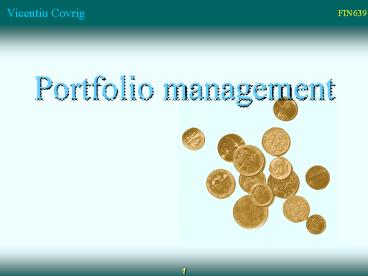Portfolio management - PowerPoint PPT Presentation
Title:
Portfolio management
Description:
Portfolio management ... Risk Aversion Portfolio theory assumes that investors are averse to ... for the individual investments in the portfolio Percentages ... – PowerPoint PPT presentation
Number of Views:384
Avg rating:3.0/5.0
Title: Portfolio management
1
- Portfolio management
2
How Finance is organized
- Corporate finance
- Investments
- International Finance
- Financial Derivatives
3
Risk and Return
- The investment process consists of two broad
tasks - security and market analysis
- portfolio management
4
Risk and Return
- Investors are concerned with both
- expected return
- risk
- As an investor you want to maximize the returns
for a given level of risk. - The relationship between the returns for assets
in the portfolio is important.
5
Risk Aversion
- Portfolio theory assumes that investors are
averse to risk - Given a choice between two assets with equal
expected rates of return, risk averse investors
will select the asset with the lower level of
risk - It also means that a riskier investment has to
offer a higher expected return or else nobody
will buy it
6
Top Down Asset Allocation
1. Capital Allocation decision the choice of the
proportion of the overall portfolio to place
in risk-free assets versus risky assets.
2. Asset Allocation decision the distribution of
risky investments across broad asset
classes such as bonds, small stocks, large
stocks, real estate etc.
3. Security Selection decision the choice of
which particular securities to hold within
each asset class.
7
Expected Rates of Return
- Weighted average of expected returns (Ri) for the
individual investments in the portfolio - Percentages invested in each asset (wi) serve as
the weights - E(Rport) S wi Ri
8
Portfolio Risk (two assets only)
When two risky assets with variances s12 and
s22, respectively, are combined into a portfolio
with portfolio weights w1 and w2, respectively,
the portfolio variance is given by ?p2
w12?12 w22?22 2W1W2 Cov(r1r2) Cov(r1r2)
Covariance of returns for
Security 1 and Security 2
9
Correlation between the returns of two securities
Correlation, ? a measure of the strength of the
linear relationship between two variables
- -1.0 lt r lt 1.0
- If r 1.0, securities 1 and 2 are perfectly
positively correlated - If r -1.0, 1 and 2 are perfectly negatively
correlated - If r 0, 1 and 2 are not correlated
10
Efficient Diversification
Lets consider a portfolio invested 50 in an
equity mutual fund and 50 in a bond fund.
Equity fund Bond fund E(Return) 11 7 St
andard dev. 14.31 8.16 Correlation -1
11
100 stocks
100 bonds
Note that some portfolios are better than
others. They have higher returns for the same
level of risk or less. We call this portfolios
EFFICIENT.
12
The Minimum-Variance Frontierof Risky Assets
13
Two-Security Portfolios with Various Correlations
return
100 stocks
? -1.0
? 1.0
? 0.2
100 bonds
?
14
The benefits of diversification
- Come from the correlation between asset returns
- The smaller the correlation, the greater the risk
reduction potential ? greater the benefit of
diversification - If r 1.0, no risk reduction is possible
- Adding extra securities with lower corr/cov with
the existing ones decreases the total risk of the
portfolio
15
Estimation Issues
- Results of portfolio analysis depend on accurate
statistical inputs - Estimates of
- Expected returns
- Standard deviations
- Correlation coefficients
16
Portfolio Risk as a Function of the Number of
Stocks in the Portfolio
Thus diversification can eliminate some, but not
all of the risk of individual securities.
?
Diversifiable Risk Nonsystematic Risk Firm
Specific Risk Unique Risk
Portfolio risk
Nondiversifiable risk Systematic Risk Market
Risk
n































